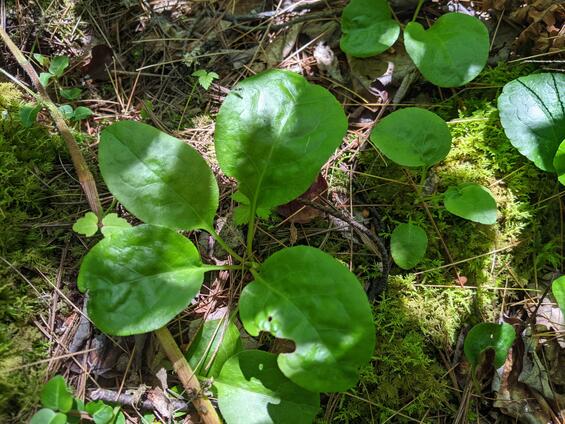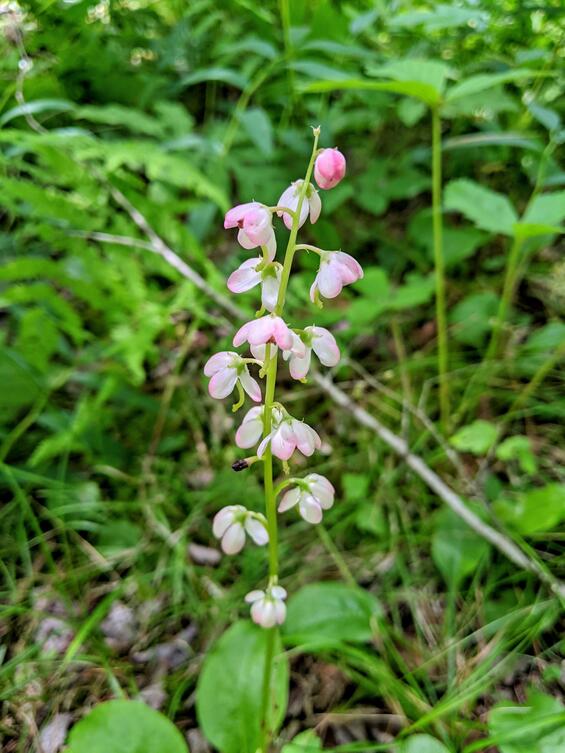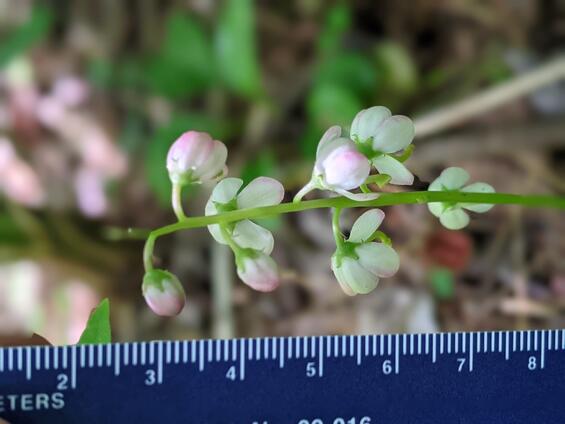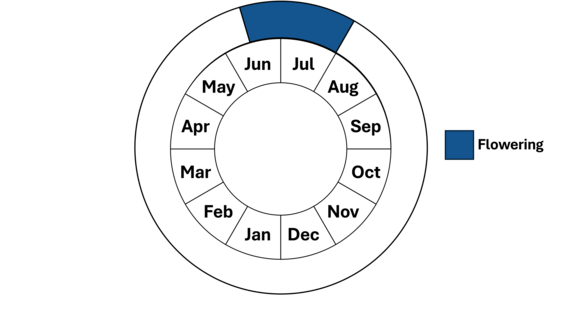- Scientific name: Pyrola asarifolia
- Species of Greatest Conservation Need (MA State Wildlife Action Plan)
- Endangered (MA Endangered Species Act)
Description

Pink shinleaf (Pyrola asarifolia)
Pink shinleaf is a delicate, perennial wildflower in the wintergreen family (Pyrolaceae). Its thick, 3-6 cm (1.2-2.4 in) long, evergreen leaves are shallowly heart-shaped at their bases. In addition, these rather roundish leaves are borne on long stalks arranged in a rosette near the base of the plant. Pink shinleaf's flower stalk reaches from 1.5-3 dm (4 -5 in) in height. Its pink or pale purple, nodding flowers occur in a raceme (an elongate, unbranched grouping of stalked flowers). Each of the 4 to 22 blossoms has five petals that are 5-7 mm (0.20-0.28 in) long and ten stamens (male reproductive organs) that open by terminal pores. Flowering season extends from mid-June to late July. Pink shinleaf's fruit is a capsule (a many-seeded fruit derived from a compound pistil).
Several other species of Pyrola occur in Massachusetts and somewhat resemble pink shinleaf. Round-leaved pyrola (P. rotundifolia) has white petals and oblong or oblong-ovate sepals. In contrast, the sepals of pink shinleaf are triangular. Shinleaf (P. elliptica) has white petals and thin, elliptic leaves. Pink shinleaf has leathery leaves. Greenish-flowered pyrola (P. chlorantha) has white petals veined with green and leaf blades that are frequently shorter than the petioles (leaf stalks). The leaf blades of pink shinleaf are as long as or longer than the petioles. Finally, of all these species, only pink shinleaf has flowers that are definitely pink or pale purple.


Life cycle and behavior
This is a perennial species.

Population status
Pink shinleaf is currently listed as endangered in Massachusetts, where there are no current populations. The Natural Heritage & Endangered Species Program has 2 records from 1 county: Berkshire. Neither record has been observed within the last 25 years. Reasons for the plant's rarity in our state include the scarcity of alkaline habitat and the fact that Massachusetts is at the southeastern limit of its range. The species Pyrola asarifolia is considered rare in New Hampshire, Vermont, New York, Iowa, and Indiana.
Distribution and abundance
The documented range of pink shinleaf extends from Newfoundland to Alaska and south to New York, northern Indiana, Minnesota, New Mexico, and Oregon.
Habitat
Pink shinleaf is found in swamps influenced by calcareous (or alkaline) groundwater seepage and in moist, limy woods. In Massachusetts, it is found only in coniferous fens (areas where cold, nutrient-poor, but calcium-rich water seeps to the surface). Among the plant species associated with pink shinleaf in this state are white pine (Pinus strobus), red maple (Acer rubrum), black ash (Fraxinus nigra), shrubby cinquefoil (Potentilla fruticosa), and dwarf raspberry (Rubus pubescens). Rare Massachusetts plants that have been found with pink shinleaf include hemlock-parsley (Conioselinum chinense) and showy lady’s-slipper (Cypripedium reginae).
Healthy habitats are vital for supporting native wildlife and plants. Explore habitats and learn about conservation and restoration in Massachusetts.
Threats
In eastern North America, this species occurs only north of a line from Minneapolis to Boston. This being a species of more northerly distribution, climate warming and more regular and severe droughts are potential threats. The past 130 years have seen a warming of 1.4 degrees C (2.5 degrees F) in the Northeast United States (Staudinger et al. 2024). Northern species can be expected to move much further north in an attempt to occupy a habitat within their evolved climate envelope. Temperature and seasonality changes also disrupt synchronization of pollinators to plant flowering. Soil moisture levels are decreasing globally (Seo et al. 2025).
As a shade adapted species of rich wet forests, threats to this species in Massachusetts include loss of canopy cover through logging operations (timber harvest), as well as through invasive arthropod attacks on tree species such as emerald ash borer, Dutch elm disease (caused by a beetle), hemlock wooly adelgid, and beech leaf disease (caused by nematodes). Deer herbivory poses an additional threat as deer populations have risen and reduced understory diversity in the eastern U.S. (Blossey & Waller 2024, Miller et al. 2023).
Conservation
Survey and monitoring
This is a short stature flowering herb that typically grows in a lush understory making discovery of populations a bit more challenging that other species. Given the fairly large area of suitable habitat, more de novo surveying is needed as well as more thorough resurvey work on known populations. All populations need increased monitoring.
Management needs
Management needs include removal and control of any invasive species, as well as avoidance of timber harvest in the area.
Research needs
As this plant is under-surveyed, standard information is needed such as lists of associated species, comments on water and habitat quality and threats, and assessments of soil conditions, soil pH, and phenology. Research is needed to determine whether this plant can be grown in a greenhouse or garden setting for purposes of reintroductions.
References
Blossey, B., D. Hare, and D. M. Waller. 2024. Where have all the flowers gone? A call for federal leadership in deer management in the United States. Frontiers in Conservation Science 5: 1382132.
Miller, K. M., S. J. Perles, J. P. Schmit, E. R. Matthews, A. S. Weed, J. A. Comiskey, M. R. Marshall, et al. 2023. Overabundant deer and invasive plants drive widespread regeneration debt in eastern United States national parks. Ecological Applications n/a: e2837.
Seo, K.-W., D. Ryu, T. Jeon, K. Youm, J.-S. Kim, E. H. Oh, J. Chen, et al. 2025. Abrupt sea level rise and Earth’s gradual pole shift reveal permanent hydrological regime changes in the 21st century. Science 387: 1408–1413.
Staudinger, M.D., A.V. Karmalkar, K. Terwilliger, K. Burgio, A. Lubeck, H. Higgins, T. Rice, T.L. Morelli, A. D'Amato. 2024. A regional synthesis of climate data to inform the 2025 State Wildlife Action Plans in the Northeast U.S. DOI Northeast Climate Adaptation Science Center Cooperator Report. 406 p.
Contact
| Date published: | May 5, 2025 |
|---|